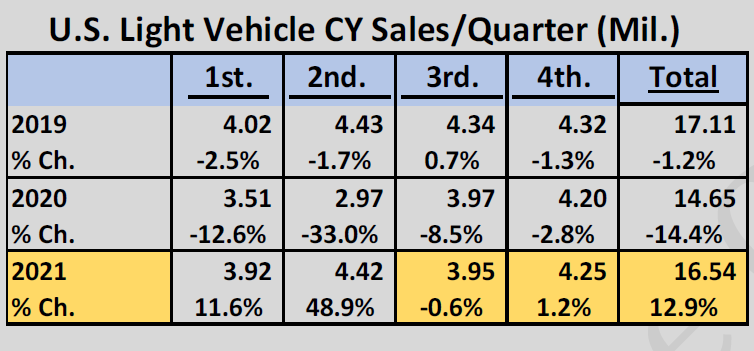Near-record light-vehicle sales in the second quarter dictate that we update our forecast.
First-half sales in 2016 were the highest since the Great Recession. Light-vehicle sales in the first half of 2021 were 97% of 2016’s performance! Not shabby, considering that suppliers and manufacturers were under significant pressure to source enough people and parts to supply vehicles.
Sourcing difficulties seemed to be everywhere; consequently, first-half North American production was the lowest since 2011. This mix of demand and supply resulted in reported dealer inventory of 2.16 million units at the end of the second quarter, or 1.6 million units below levels in 2016 and 2019.
How, then, could U.S. sales divisions deliver such outstanding performance with so little inventory? We do not think the system suddenly became more efficient, delivering inventory to dealers in an almost hand-to-mouth fashion.
We do think there was unreported fat in the system. Based on our estimates, there is substantial stock at factories, ports and in-transit. This additional inventory may be obvious to logistics insiders at OEMs, less so at parts suppliers.
First-quarter additional inventory was substantial, an additional 20 days’ supply. We estimated total system inventory on April 1, 2021, was 3.68 million units. This inventory was a huge sales enabler.
Second- and third-quarter sales will lower total inventory to 2.86 million. This “forced” inventory kaizen will supplement lower supply from regular production. Consequently, the negative influence on sales from the parts and people shortage is not as severe as originally estimated – this year. Total inventory at year-end will be 3.06 million, a lean 65 days’ supply. (60 days’ supply at dealers).
Demand Meets Supply
We said earlier that increased vehicle production in the fourth quarter would help alleviate any perceived supply shortage. We now recognize current vehicle pricing and lower incentives have already solved that problem.

WP Browne Consulting LLC
Recent reports have indicated that vehicle prices have increased this year by 12%-17% due to a combination of increased sticker prices, mix, lower incentives and margin changes. If you assume an industry trend of 16.9 million sales in 2019, then 15.9 million sales in 2021 is a reasonable estimate of demand given the price increase. Add 650,000 units of unmet demand from 2020 and you have our current outlook. Price has cleared the market; shortage solved – this year.
The 2021 light-vehicle sales forecast is now 16.54 million, an increase of 750,000 from January estimates.
A New Business Model?
Vehicle manufacturers currently have very lean inventory, significantly improved margins and strong sales. COVID disruptions have potentially created a new paradigm:
• An industry days’ supply standard that is closer to 50 days than 80 days.
• A determination to maintain vehicle margins at their current levels.
These policy changes would be great for shareholders. It would be bad for consumers looking for good deals or suppliers looking for high-volume runs. It will be interesting to see which manufacturers blink first and move away from our suggested change in thinking.
Warren Browne is president of WP Browne Consulting LLP. He also serves as adjunct professor of economics and trade at Lawrence Technological University.
WP Browne Consulting LLC





